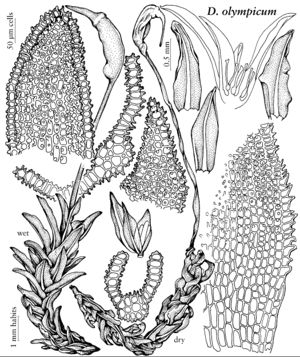Dichodontium olympicum
Bot. Gaz. 17: 296. 1892,.
Stems 0.4–0.8 cm. Leaves 1–2.2 mm, apex rounded-obtuse to obtusely acute, occasionally truncate; leaf margins mostly plane at base, rarely some leaves recurved, prominently papillose near insertion, margins of leaf apex strongly papillose but without teeth; laminal cells at margins strongly papillose by projecting distal cell ends to within 6–10 cells of the insertion; median leaf cells with horned (sometimes branched) papillae on both surfaces; costal cells adaxially quadrate or short-rectangular (1–2:1), papillose, scarcely different from adjacent laminal cells. Specialized asexual reproduction unknown. Sexual condition autoicous, perigonium located just below the perichaetium. Seta 4–8 mm. Capsule 1–1.4 mm, strumose, irregularly furrowed when dry. Spores 10–15 µm.
Phenology: Capsules mature summer–fall (Jul–Oct).
Habitat: Wet soil or soil over rock, montane areas, especially associated with melting snow
Elevation: moderate to high elevations (1000-2200 m)
Distribution

Alta., B.C., Calif., Idaho, Mont., Wash.
Discussion
Rarely, one or both leaf margins may be recurved to various extents in some of the larger leaves of Dichodontium olympicum. The costa near the leaf insertion is 50–62 µm across, while that of D. pellucidum varies from 30 to 100 µm. The leaves are strongly papillose-mammillose. The margins are evenly denticulate, whereas in D. pellucidum similar denticulations are interrupted at intervals by teeth with the outer edge curving toward the apex. The papillae salients tend to become more prominent on the leaf margins approaching the leaf insertion. There does not appear to be a hydroid strand in the costa in the proximal leaf section, which could help differentiate this species from D. pellucidum, which often possesses this feature in robust (longer) stems and leaves.
Dichodontium olympicum is often cited as dioicous in past literature, while J.-P. Frahm et al. (1998) correctly noted its autoicous sexuality but did not include this useful character in their key to species. Since the sexuality of the genus is often said to in part differentiate Dichodontium from other genera, such as Cynodontium, which has autoicous species, one wonders how artificial Dichodontium and other closely related genera are, as several characters, such as strumiferous capsules and the striking “horned” papillae and variously undifferentiated costa anatomy, seem to vary independently of generic limits.
Dichodontium integrum Sakurai has been cited by Gao C. et al. (1999) for the flora of China, without observation of specimens, but indicating that the species, based on a translation of part of the protologue, “is similar to the North American Dichodontium olympicum.” The description given, however, lacks the essential distinctions of D. olympicum. Further inquiry is needed.
Selected References
None.
